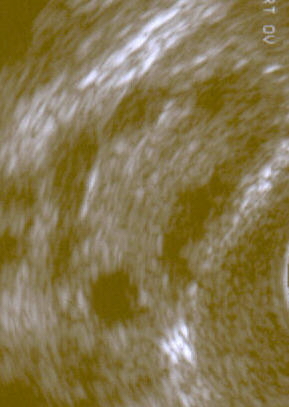กลุ่มอาการรังไข่มีถุงน้ำจำนวนมาก
| กลุ่มอาการรังไข่มีถุงน้ำจำนวนมาก (polycystic ovary syndrome) | |
|---|---|
| ชื่ออื่น | Hyperandrogenic anovulation (HA),[1] Stein–Leventhal syndrome[2] |
 | |
| ภาพอัลตราซาวนด์แสดงให้เห็นถุงน้ำจำนวนมากในรังไข่ของผู้ป่วย | |
| สาขาวิชา | Gynecology |
| อาการ | Irregular menstrual periods, heavy periods, excess hair, acne, pelvic pain, difficulty getting pregnant, patches of thick, darker, velvety skin[3] |
| ภาวะแทรกซ้อน | Type 2 diabetes, obesity, obstructive sleep apnea, heart disease, mood disorders, endometrial cancer[4] |
| ระยะดำเนินโรค | Long term[5] |
| สาเหตุ | Genetic and environmental factors[6][7] |
| ปัจจัยเสี่ยง | Obesity, not enough exercise, family history[8] |
| วิธีวินิจฉัย | Based on no ovulation, high androgen levels, ovarian cysts[4] |
| โรคอื่นที่คล้ายกัน | Adrenal hyperplasia, hypothyroidism, hyperprolactinemia[9] |
| การรักษา | Weight loss, exercise[10][11] |
| ยา | Birth control pills, metformin, anti-androgens[12] |
| ความชุก | 2% to 20% of women of childbearing age[8][13] |
กลุ่มอาการรังไข่มีถุงน้ำจำนวนมาก (อังกฤษ: polycystic ovary syndrome, PCOS) เป็นกลุ่มอาการอย่างหนึ่งที่เกิดจากการมีฮอร์โมนเพศชายสูงผิดปกติในผู้หญิง[4] อาการและอาการแสดงได้แก่ ประจำเดือนมาไม่ปกติหรือขาดประจำเดือน ประจำเดือนมามาก มีขนมาก มีสิว ปวดท้องน้อย มีบุตรยาก ผิวหนังหนาและมีสีดำ[14] ภาวะอื่นๆ ที่อาจพบร่วม ได้แก่ เบาหวาน ความอ้วน หยุดหายใจขณะหลับ โรคหัวใจ โรคทางอารมณ์ และมะเร็งเยื่อบุโพรงมดลูก เป็นต้น[4]
สาเหตุของ PCOS เกิดจากทั้งพันธุกรรมและสิ่งแวดล้อม[7] ปัจจัยเสี่ยงที่สำคัญได้แก่ความอ้วน การออกกำลังกายไม่เพียงพอ และการมีญาติที่มีภาวะเดียวกันนี้[8] การวินิจฉัยทำได้โดยการตรวจพบอาการสองในสามอย่าง ได้แก่ การไม่มีการตกไข่ ระดับฮอร์โมนแอนโดรเจนที่สูง และการมีถุงน้ำในรังไข่[4] ถุงน้ำในรังไข่นี้อาจตรวจพบได้จากการตรวจอัลตราซาวนด์ ภาวะอื่นๆ ที่อาจทำให้มีอาการคล้ายกันได้แก่ ต่อมหมวกไตเจริญมากเกิน ต่อมไทรอยด์ทำงานน้อย และภาวะโปรแล็กตินในเลือดสูง เป็นต้น[9]
อ้างอิง
[แก้]- ↑ Kollmann M, Martins WP, Raine-Fenning N (2014). "Terms and thresholds for the ultrasound evaluation of the ovaries in women with hyperandrogenic anovulation". Hum. Reprod. Update. 20 (3): 463–4. doi:10.1093/humupd/dmu005. PMID 24516084.
{{cite journal}}: CS1 maint: uses authors parameter (ลิงก์) - ↑ "USMLE-Rx". MedIQ Learning, LLC. 2014.
Stein-Leventhal syndrome, also known as polycystic ovary syndrome (PCOS), is a disorder characterized by hirsutism, obesity, and amenorrhea because of luteinizing hormone-resistant cystic ovaries.
{{cite web}}:|url=ไม่มีหรือว่างเปล่า (help) - ↑ "What are the symptoms of PCOS?". nichd.nih.gov. คลังข้อมูลเก่าเก็บจากแหล่งเดิม (05/23/2013)เมื่อ 3 March 2015. สืบค้นเมื่อ 13 March 2015.
- ↑ 4.0 4.1 4.2 4.3 4.4 "Polycystic Ovary Syndrome (PCOS): Condition Information". nichd.nih.gov. 2013-05-23. สืบค้นเมื่อ 13 March 2015.
- ↑ "Is there a cure for PCOS?". US Department of Health and Human Services, National Institutes of Health. 2013-05-23. คลังข้อมูลเก่าเก็บจากแหล่งเดิมเมื่อ 5 April 2015. สืบค้นเมื่อ 13 March 2015.
- ↑ De Leo V, Musacchio MC, Cappelli V, Massaro MG, Morgante G, Petraglia F (2016). "Genetic, hormonal and metabolic aspects of PCOS: an update". Reproductive Biology and Endocrinology : RB&E (Review). 14 (1): 38. doi:10.1186/s12958-016-0173-x. PMC 4947298. PMID 27423183.
- ↑ 7.0 7.1 Diamanti-Kandarakis E, Kandarakis H, Legro RS (2006). "The role of genes and environment in the etiology of PCOS". Endocrine. 30 (1): 19–26. doi:10.1385/ENDO:30:1:19. PMID 17185788.
{{cite journal}}: CS1 maint: uses authors parameter (ลิงก์) - ↑ 8.0 8.1 8.2 "How many people are affected or at risk for PCOS?". nichd.nih.gov. 2013-05-23. สืบค้นเมื่อ 13 March 2015.
- ↑ 9.0 9.1 "How do health care providers diagnose PCOS?". nichd.nih.gov. 2013-05-23. สืบค้นเมื่อ 13 March 2015.
- ↑ Mortada R, Williams T (2015). "Metabolic Syndrome: Polycystic Ovary Syndrome". FP Essentials (Review). 435: 30–42. PMID 26280343.
- ↑ Giallauria F, Palomba S, Vigorito C, Tafuri MG, Colao A, Lombardi G, Orio F (2009). "Androgens in polycystic ovary syndrome: the role of exercise and diet". Seminars in Reproductive Medicine (Review). 27 (4): 306–15. doi:10.1055/s-0029-1225258. PMID 19530064.
- ↑ National Institutes of Health (NIH) (2014-07-14). "Treatments to Relieve Symptoms of PCOS". คลังข้อมูลเก่าเก็บจากแหล่งเดิมเมื่อ 2 April 2015. สืบค้นเมื่อ 13 March 2015.
- ↑ editor, Lubna Pal, (2013). "Diagnostic Criteria and Epidemiology of PCOS". Polycystic Ovary Syndrome Current and Emerging Concepts. Dordrecht: Springer. p. 7. ISBN 9781461483946. คลังข้อมูลเก่าเก็บจากแหล่งเดิมเมื่อ 2017-09-10.
{{cite book}}:|last1=มีชื่อเรียกทั่วไป (help)CS1 maint: extra punctuation (ลิงก์) - ↑ "What are the symptoms of PCOS?" (05/23/2013). nichd.nih.gov. สืบค้นเมื่อ 13 March 2015.
แหล่งข้อมูลอื่น
[แก้]| การจำแนกโรค | |
|---|---|
| ทรัพยากรภายนอก |
